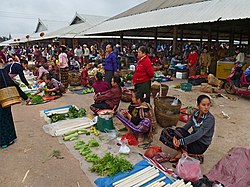Muang Sing
|
Sing ເມືອງສີງ |
|
|---|---|
| Muang (district) and town | |

Muang Sing market, formerly a major opium market in the Golden Triangle
|
|
| Coordinates: 21°12′N 101°9′E / 21.200°N 101.150°E | |
| Country | Laos |
| Province | Luang Namtha |
| Established | 1792 |
| Area | |
| • Total | 1,650 km2 (640 sq mi) |
| Population (2000) | |
| • Total | 23,500 |
| • Density | 14.2/km2 (37/sq mi) |
| In the district | |
| Time zone | Laos Standard Time (UTC+7) |
Muang Sing or Mueang Sing (Lao: ເມືອງສີງ) is a small town and district (muang) in Luang Namtha Province, northwestern Laos, about 60 kilometres northwest of the town of Luang Namtha and 360 kilometres northwest of Vientiane. It lies very close to the border with Yunnan, China, surrounded by mountains and rivers. Historically, Mueang Sing has been a major producer of opium and still has problems with drugs and smuggling, due to its geographical position close to China and Burma. A notable Buddhist centre, with a dramatic growth in temples since the 1980s, it is popular with trekkers in northern Laos.
Not much is known about the history of the town before the 18th century. A walled settlement named Wiang Fa Ya was founded by the widow of the ruler of Chiang Khaeng and in 1792 she ordered the construction of a large stupa. The district of Muang Sing was the subject of a border dispute between the French and British for decades. The French set up a garrison here in 1876. Muang Sing was never formally incorporated into the kingdom of Xishuangbanna in the late 19th century and the ruler of Muang Sing, Chao Fa Sirinor, ruled the area as a semi-autonomous principality in the late 19th century. In 1885, Sirinor moved the capital of his Lue principality of Chiang Khaeng to Muang Sing, several kilometres to the southeast, bringing with him some 1000 Lue people. Because of its important position geographically, the people of the town have historically been on better terms with the Burmese, Thai and Chinese people than the rest of Laos. However, it has continued to attract Lue pilgrims to its reliquary festival from Xishuangbanna since at least World War II due to its past.
In 1904, Muang Sing was incorporated in French Laos after France and Great Britain made an agreement. In 1907, the Governor-General of Indochina in Hanoi issued a decree to establish the post of a "delegue du Commissaire du Gouvernement" at Muang Sing. It became part of French Indochina in 1916, but the locals continued to show discontent with the French occupation. In the first half of the 20th century, the French capitalized on the location of the town by using it as a weigh station and market to regulate their opium monopoly, Opium Regie, and control production by the Hmong and Mien peoples. By World War II, some 15% of the colonial revenue of the French was obtained through opium trading. When changes in the international situation after the war blocked off many historical trading routes, the French government encouraged Hmong farmers to mass-produce the poppies by some 800% to compete and maintain their monopoly. In 1953, however, Laos became independent from France and trading declined until the 1990s, when the opening of the country to tourism saw many people arriving in the area to smoke opium, leading to the reopening of drug dens.
...
Wikipedia

